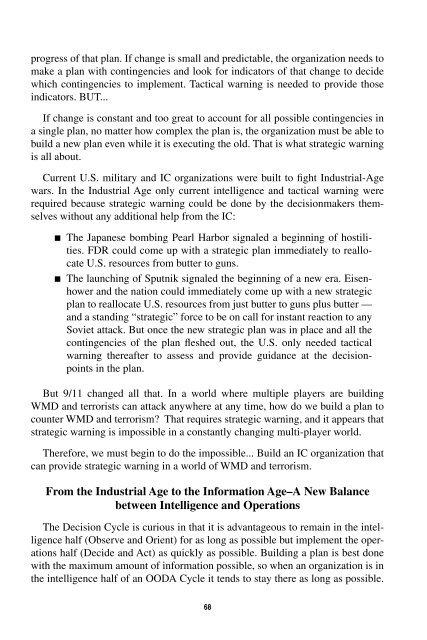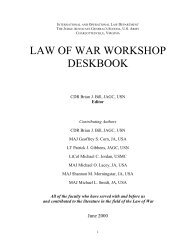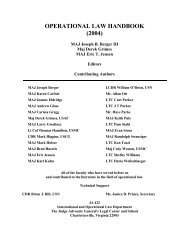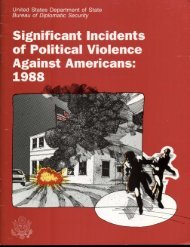Warning Analysis for the Information Age - Higgins Counterterrorism ...
Warning Analysis for the Information Age - Higgins Counterterrorism ...
Warning Analysis for the Information Age - Higgins Counterterrorism ...
Create successful ePaper yourself
Turn your PDF publications into a flip-book with our unique Google optimized e-Paper software.
progress of that plan. If change is small and predictable, <strong>the</strong> organization needs tomake a plan with contingencies and look <strong>for</strong> indicators of that change to decidewhich contingencies to implement. Tactical warning is needed to provide thoseindicators. BUT...If change is constant and too great to account <strong>for</strong> all possible contingencies ina single plan, no matter how complex <strong>the</strong> plan is, <strong>the</strong> organization must be able tobuild a new plan even while it is executing <strong>the</strong> old. That is what strategic warningis all about.Current U.S. military and IC organizations were built to fight Industrial-<strong>Age</strong>wars. In <strong>the</strong> Industrial <strong>Age</strong> only current intelligence and tactical warning wererequired because strategic warning could be done by <strong>the</strong> decisionmakers <strong>the</strong>mselveswithout any additional help from <strong>the</strong> IC:■ The Japanese bombing Pearl Harbor signaled a beginning of hostilities.FDR could come up with a strategic plan immediately to reallocateU.S. resources from butter to guns.■ The launching of Sputnik signaled <strong>the</strong> beginning of a new era. Eisenhowerand <strong>the</strong> nation could immediately come up with a new strategicplan to reallocate U.S. resources from just butter to guns plus butter —and a standing “strategic” <strong>for</strong>ce to be on call <strong>for</strong> instant reaction to anySoviet attack. But once <strong>the</strong> new strategic plan was in place and all <strong>the</strong>contingencies of <strong>the</strong> plan fleshed out, <strong>the</strong> U.S. only needed tacticalwarning <strong>the</strong>reafter to assess and provide guidance at <strong>the</strong> decisionpointsin <strong>the</strong> plan.But 9/11 changed all that. In a world where multiple players are buildingWMD and terrorists can attack anywhere at any time, how do we build a plan tocounter WMD and terrorism? That requires strategic warning, and it appears thatstrategic warning is impossible in a constantly changing multi-player world.There<strong>for</strong>e, we must begin to do <strong>the</strong> impossible... Build an IC organization thatcan provide strategic warning in a world of WMD and terrorism.From <strong>the</strong> Industrial <strong>Age</strong> to <strong>the</strong> In<strong>for</strong>mation <strong>Age</strong>–A New Balancebetween Intelligence and OperationsThe Decision Cycle is curious in that it is advantageous to remain in <strong>the</strong> intelligencehalf (Observe and Orient) <strong>for</strong> as long as possible but implement <strong>the</strong> operationshalf (Decide and Act) as quickly as possible. Building a plan is best donewith <strong>the</strong> maximum amount of in<strong>for</strong>mation possible, so when an organization is in<strong>the</strong> intelligence half of an OODA Cycle it tends to stay <strong>the</strong>re as long as possible.68
















